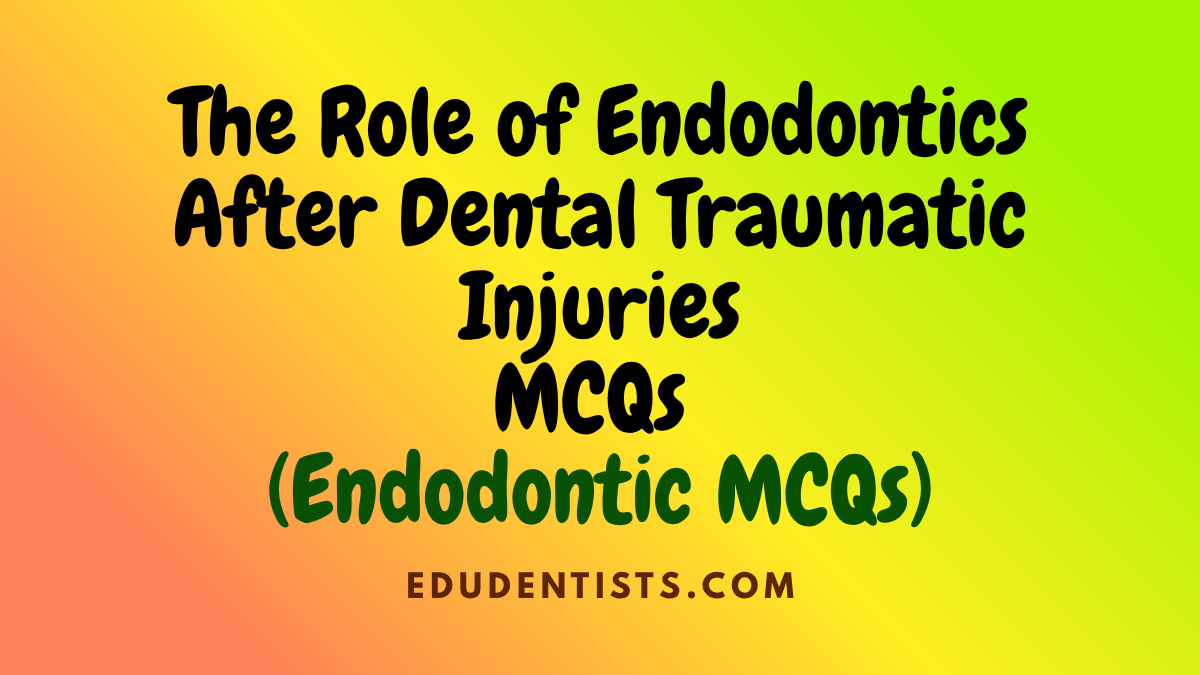
The Role of Endodontics After Dental Traumatic Injuries _ Endodontics MCQs
The Role of Endodontics After Dental Traumatic Injuries _ Endodontics MCQs
1. Initial vitality testing of traumatized teeth is most useful for:
A) Establishing a baseline for comparison with future testing
B) Determining whether root canal treatment is indicated
C) Determining whether the blood supply to the pulp has been compromised
D) Predicting the prognosis
2. A normal periapical radiograph of a traumatized tooth is useful for:
A) Visualizing most root fractures
B) Visualizing concussion injuries
C) Gathering baseline information
D) Locating foreign objects
3. Which of the following statements about crown infraction is accurate:
A) It may indicate luxation injuries.
B) It is rarely seen on transillumination.
C) It seldo m requires a follow-up examination.
D) It describes the process of coronal pulp necrosis.
4. Which of the following statements about uncomplicated crown fracture is accurate:
A) It is an indication for a dentin-bonded restoration.
B) It requires baseline pulp testing.
C) It involves root canal treatment if the exposed dentin is sensitive to cold stimulus.
D) It has a questionable long-term prognosis.
E) It is managed differently in young patients than in older patients.
5. Which of the following statements about complicated crown fractures is accurate:
A) Exposure to the oral cavity permits rapid bacterial penetration through the pulp.
B) Inflammation is limited to the coronal 2 mm of the exposed pulp for the first 24 hours.
C) The tooth is normally managed by root canal treatment and restoration.
6. Which of the following statements about replacement resorption is accurate:
A) It results from direct contact between root, dentin, and bone.
B) It is managed by surgical exposure and repair with a biocompatible material.
C) It results when at least 75 of the root surface is damaged.
D) It can be avoided by timely endodontic intervention.
7. Pulp necrosis is most likely to occur after which of the following:
A) Midroot fracture
B) Intrusive luxation
C) Concussion
D) Complicated crown fracture
8. Which of the following statements about internal root resorption is accurate:
A) It is a common, self-limiting result of luxation injury.
B) It causes significant pulpal symptoms.
C) It can be arrested by root canal treatment.
D) It may extend coronally to present as a pink spot on the crown.
9. Which medium of storage for an avulsed tooth is best for prolonged extraoral periods:
A) Hanks Balanced Salt Solution
B) Milk
C) Distilled water
D) Saliva
10. The most important factor in the management of avulsions is:
A) Extraoral time
B) Decontamination of the root surface
C) Prompt initiation of root canal treatment
D) Proper preparation of the socket
11. Which of the following statements about a Cvek pulpotomy is accurate:
A) It is performed on a fully developed tooth with a carious pulp exposure.
B) Pulp tissue is removed to the level of the canal orifice.
C) Sensitivity testing is a critical tool for determining pulpal status.
D) One to 2 mm of coronal pulp tissue is removed, and calcium hydroxide is placed directly on the pulp.
12. Which of the following statements is true about thermal and electrical tests after trauma:
A) Sensitivity tests evaluate the nerve and circulatory condition of the tooth.
B) False-positive test results are more likely than false-negative results.
C) It may take up to 9 months for normal blood flow to return.
D) None of the above
13. Which of the following statements about internal root resorption is accurate:
A) It is rare in deciduous teeth.
B) It is initiated by odontoblasts.
C) It is seldo m confused with external resorption.
D) It is usually asymptomatic.
14. Which of the following statements about avulsed teeth is accurate:
A) They can be treated endodontically outside the mouth in limited circumstances.
B) They should be rigidly splinted for 3 to 4 weeks to allow periodontal support to mature.
C) They generally do not require antibiotic treatment at the time of replantation.
D) Apexification should be attempted if the apex is not closed.
15. Pulp regeneration can be considered only if:
A) A mature tooth has been avulsed
B) An immature permanent tooth with incomplete root development has been avulsed
C) A deciduous tooth has been avulsed
D) The patient is asymptomatic
16. Which of the following statements about horizontal root fractures is accurate:
A) Pulp necrosis always occurs.
B) Root canal treatment is indicated within 7 to 10 days.
C) The prognosis for retention is hopeless, and the tooth should be extracted.
D) Pulp tissue in the apical segment frequently remains vital.
17. Localized injury to the external root surface results in:
A) Pulp necrosis and ankylosis
B) Damage to the pulp
C) (Possibly) a localized radiolucent area adjacent to the area of injury, which may show spontaneous healing
D) Internal resorption after pulpal necrosis
18. When should root canal treatment be initiated for a serious injury in which regeneration is impossible:
A) Immediately
B) Seven to 10 days after injury
C) Three to 4 weeks after injury
D) The next day
19. A young tooth with an immature apex has been avulsed, with a dry time of less than 60 minutes. Placement of the tooth into which of the following increases the chance of revascularization:
A) Aqueous calcium hydroxide
B) Penicillin
C) Citric acid
D) Doxycycline